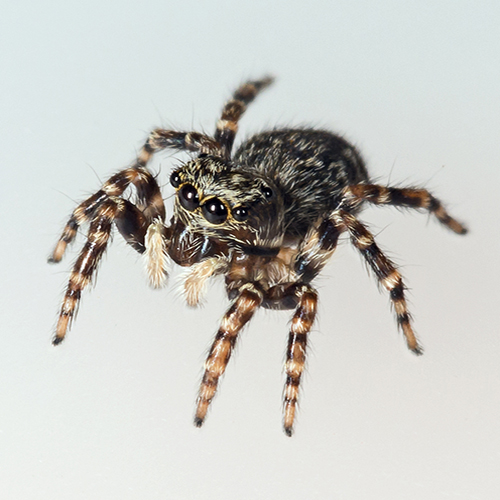Myth: You can identify "brown recluse" spiders by a violin shape.
Fact: Because of this myth, brown recluses are also called "violin" or "fiddleback" spiders. Although the "fiddle mark" does exist (not always very fiddle-like), it is worthless in identification!

Most spiders have 8 eyes in 2 rows like Tegenaria (right). Brown recluses (left) and about 430 other spiders (less than 1% of all spiders) have 6 eyes in 3 pairs. Note: front views. Other eye arrangements exist.
Many spiders, in assorted families, including the real Loxosceles reclusa, have a vaguely violin-like spot right behind the eyes. The number of species with such a spot, by itself would limit this spot's usefulness for identification!
But most people who have heard this myth forget about the "right behind the eyes" part, and identify as "brown recluses" any spider in which any part of the body or pattern can be envisioned as violin-shaped. That includes the vast majority of all spiders! I have seen every common house spider in my region (where the real thing does not occur) misidentified in this way.
The spider family (Sicariidae) to which the recluse group belongs is recognized partly by the arrangement of the eyes, which would rule out 99% of the specimens that get misidentified — if anyone ever bothered to look for anything but that mythical "violin"! At species level, as in other spiders, a powerful microscope is needed to identify recluses, and in females, it is even necessary to cut open the abdomen and examine internal parts!
And yet every first-aid manual, every public-health bulletin, every book and pamphlet on outdoor safety that deals with spiders lets readers believe that you can recognize this extremely hard-to-identify spider by that absurd "violin" shape. It is one of the most widely disseminated bits of spider misinformation, and I'm convinced that health care professionals learn it in medical school too!
And of course, every place you find the "violin" myth, you'll also fail to find any suggestion that the spider occurs only in a limited region - thousands of miles away from where most of the fearful readers live!







